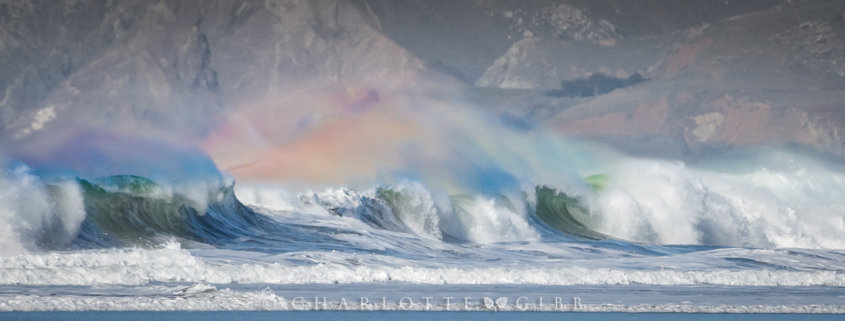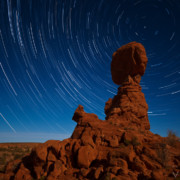When to Use Fast Shutter Speed in Landscape Photography
Let’s face it. Landscape photographers are fond of using slow shutter speeds in landscape photography. Consider waterfalls blurred into a luscious, silky texture, or long exposure night sky photography where stars appear in ways only the camera can reveal. Or think of wide near-far compositions in landscape photography, with every object in sharp focus. Unlike other genres such as wildlife, street, or sports photography, landscape photographers often work slowly and methodically. Armed with a tripod and shutter release, they are perfectly at ease in low-light situations.
So under which conditions would a landscape photographer even bother using a fast shutter speed for landscapes? The answer:
When the subject is moving or the camera is moving and the intent is to freeze the action of the subject.
Overcoming Wind
Wind can be the enemy, especially when photographing trees or foliage. In the words of a landscape photographer friend of mine, “wind is a four-letter word.”
Sure, you can combine long exposure photography with subject movement to create artistic effects. But if your goal is to present a still, sharp scene, you must either pick a calm, windless day—or increase your shutter speed. A fast shutter speed in windy conditions allows you to freeze both subject and camera movement.
As you increase shutter speed, you must compensate with a wider aperture, higher ISO, or both, to maintain correct exposure. Each option comes with trade-offs: higher ISO introduces noise, and a wider aperture reduces depth of field.
I used a faster shutter speed to freeze the movement of trees in the image above. Strong winds can also jostle the camera, making it difficult to achieve a tack-sharp photo. While you can stabilize your tripod with weights or shorten its legs to overcome windy conditions. But, if there is a strong, consistent wind, the most effective choice is to use a shutter speed fast enough to freeze motion in landscape photography.
Freezing Motion of Waves

Fast shutter speed was used to freeze movement in this handheld photo – Exposure: f/10, 1/1600, ISO 500
Powerful and beautiful, waves capture our imagination with their endless energy. Using a fast shutter speed for ocean photography communicates the strength and force of water in motion. A long exposure makes water appear calm and dreamlike, which is ideal if that is your intent. But when the goal is to show the dynamic energy of crashing waves, a fast shutter speed is the better choice.
Shooting Waterfalls
Waterfalls charm us with their misty, graceful beauty. Most photographers use slow shutter speed waterfall photography to create silky, milky textures. But with a faster shutter speed, you can freeze every droplet and capture a unique frame with each click. Using a fast shutter speed for waterfalls brings out drama, texture, and unpredictability.
Photographing Critters or Humans
If you include an animal or person in your composition, a high shutter speed in outdoor photography is essential to freeze motion.
I used a fast shutter speed to freeze the movement of a friend in the photo above. Many times while photographing a quiet scene, wildlife unexpectedly appears—a bird, a duck, or even a deer. In these cases, I rely on a custom setting of f/8, ISO 800, 1/500 sec, allowing me to quickly switch to wildlife photography with fast shutter speed. This setting is just a starting point and, depending upon the situation, I can adjust the shutter speed according to the scene. To freeze a bird’s wings in flight, for example, a shutter speed of at least 1/1000 is required.
Shooting Ripples
Photographing ripples in a pool or lake is great fun, offering infinite possibilities for creative compositions. Use fast shutter speed for abstract water photography to freeze subtle wave patterns. Experiment with different shutter speeds—1/500th or faster is often ideal—to discover how speed changes the look and mood of your water images.
Photographing in a Snowstorm
Falling snow is magical to capture at varying shutter speeds. While slower exposures create streaks, a fast shutter speed in snow photography allows each flake to be seen clearly. In the image above, freezing the snowflakes with a fast shutter speed gave a sense of depth, energy, and atmosphere in the scene.
For Hand-Held Landscape Photography
There are times when you don’t have a tripod—or aren’t allowed to use one due to restrictions. In such cases, follow this rule of thumb: shutter speed = 2x focal length. If your lens focal length is 400mm, use at least 1/800 sec; if it’s 100mm, keep it at 1/200 sec or faster.
Even at higher shutter speeds, camera shake can still blur an image. To minimize this, use fast shutter speeds for handheld landscape photography and, if using a DSLR, shoot with the mirror up. Mirrorless cameras are not affected by this issue.
Final Thoughts
Landscape photographers aren’t always bound to long exposure photography techniques. There are many situations where it is more effective to speed things up. From freezing waves with fast shutter speed to capturing snowflakes, ripples, and wildlife in motion, faster shutter speeds provide a different creative toolkit.
So, the next time you are out in the field, ask yourself: In which situations is a fast shutter speed in landscape photography the best solution?
Original Article Published in Jan 2020.















